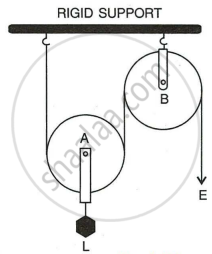Advertisements
Advertisements
प्रश्न
Give a reason for the following:
In a single fixed pulley, the velocity ratio is always more than the mechanical advantage.
उत्तर
In a single fixed pulley, some effort is wasted in overcoming friction between the strings and the grooves of the pulley; so the effort needed is greater than the load and hence the mechanical advantage is less than the velocity ratio.
APPEARS IN
संबंधित प्रश्न
Is the above pulley system an ideal machine or not?
State two functions of a machine.
What is the justification for using the pulley then ?
What should be the gear ration of a car : equal to 1, less than 1 or greater than 1, while ascending a hill ?
The diagram below shows a pulley arrangement.
- Name the pulleys A and B.
- In the diagram, mark the direction of tension on each strand of string.
- What is the purpose of the pulley B?
- If the tension is T, deduce the relation between
- T and E, and
- E and L.
- What is the velocity ratio of the arrangement?
- Assuming that the efficiency of the system is 100%, what is the mechanical advantage?

Differentiate between a single fixed pulley and a single movable pulley.
Give reason for the following:
In a single fixed pulley, the velocity ratio is always more than the mechanical advantage.
There is no gain in mechanical advantage in the case of a single fixed pulley. Explain, why the pulley is then used?
The pulley system shown in the figure is to be used to lift a load W. If the man applying the effort cannot apply a force exceeding 1000 N, what is the maximum load that can be lifted?
The actual load that the man is finally able to lift turns out to be 2700 N. What are the values of the actual M.A., obtained, and the efficiency of the actual set-up?
A boy lifts a load of 40 kgf through a vertical height of 2m in 5s by using a single fixed pulley when he applies an effort of 48 kgf. Calculate:
(i) the mechanical advantage, and
(ii) the efficiency of the pulley. Why is the efficiency of the pulley is not 100%?
(iii) the energy gained by the load in 5s, and
(iv) the power developed by the boy in raising the load.
